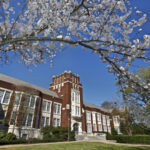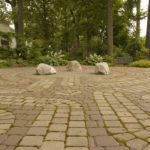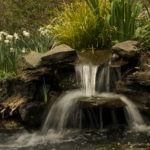Amazing Port Street Sacred Commons
An inner-city haven for healing, redemption and renewal
The 90s was a dark decade for McElderry Park. It once topped the list of most violent places in Baltimore. Previously a thriving family-centered community, it had deteriorated into a den of crime, drug dealers and untimely deaths. Families and businesses fled. Abandoned homes sheltered squatters. Empty lots became dumping grounds. But two bright lights within this urban blight worked hard to turn that around. It started with a garden, then sprouted into a labyrinth, an adjacent greenspace and eventually a community center with two more lots.

Pastor Karen Brau came to the community during that time to serve the Amazing Grace Evangelical Lutheran Church. A former commercial banker with a history of Lutheran pastors in her family, she found her calling in urban ministry. Resident Jerry Waters had called this community his home for over 20 years and witnessed the decline. But he didn’t want to leave. This neighborhood was still very close knit and special to him his neighbors. He wanted to celebrate its strengths and help revitalize it into the thriving community he knew it could be again.
Together, with Nature Sacred’s help and an outpouring of community effort, they made Amazing Port Street Sacred Commons come to life.

What we’re doing here is hard and profound work. We’re transforming this neighborhood in the face of what seems impossible. And we’re not giving up.
—Firesoul and Amazing Grace Evangelical Lutheran Church Pastor Karen Brau
Planting the seeds

Pastor Brau arrived at her new post and observed how drug addiction afflicted her new neighborhood. Nearly every household had at least one actively addicted family member. She saw how it affected the family unit, the economy, the level of anxiety in the community. Because, along with drugs come drug dealers and gangs, crime and violence. People were scared to leave their houses and feared for their children’s lives. Her community was dying on the vine.
So Pastor Brau decided to plant a garden. She knew nature heals. She wanted to do something concrete that engaged a passion she’d cultivated in her childhood and her congregation—especially the children, who were most vulnerable and represented the community’s future. Something that was hands-on, meaningful and would produce results for everyone to enjoy.

That garden grew to include a labyrinth when the city tore down some houses adjacent to and behind the church. Though the city’s plan to rebuild the space crumbled, Pastor Brau and kids in her church summer camp created small labyrinths from the rubble and found objects.
But she envisioned taking the labyrinth to the next level, which required resources beyond her capabilities. That’s when she partnered with Jerry Waters and the McElderry Park Community Association.
A collective effort—church, community and beyond
 Church and community combined forces to expand upon Pastor Brau’s labyrinth idea. They enlisted Nature Sacred’s help to bring it to fruition. The city brought pieces of telephone poles and planted them around the labyrinth to serve as the “surround” to the sacred space. The children painted them into brightly colored totem poles.
Church and community combined forces to expand upon Pastor Brau’s labyrinth idea. They enlisted Nature Sacred’s help to bring it to fruition. The city brought pieces of telephone poles and planted them around the labyrinth to serve as the “surround” to the sacred space. The children painted them into brightly colored totem poles.
When they started, drug dealers were selling and junkies were shooting up. Pastor Brau and Jerry walked the property daily picking up used syringes before allowing volunteers on site. Jerry—“not much of a dirt person”—was there every day hauling out debris, digging, laying stones in the hot sun and shooing away drug foot traffic. When they finished, Pastor Brau walked the labyrinth most days, and Jerry continued to ask lurking drug dealers to move on.
During this process, the community association received a house and piece of land across the street from the labyrinth as a gift. Church and community turned that land into an urban greenspace—a lawn and flower garden with marigolds planted to spell out “love.”
As the project expanded, word about the project spread, and people from Baltimore and beyond came by the busload to help. Volunteers from the United Way. Travelers from Australia wanting to pitch in. Even sailors from a submarine docked at the Inner Harbor!

A maze of grace
Drug dealers stay away. Children play. Some of the same people who used to throw trash now pick it up, walk the labyrinth, and enjoy the greenspace.
Former addicts rekindle their faith, find peace and move into recovery. Pastor Brau encouraged one such woman who visited the labyrinth to become more involved in the church. She eventually participated in a group that met in the labyrinth to talk about faith and ended up working toward recovery.
Gangs find solace in this sacred space. One day, several local gang members entered the labyrinth. A concerned neighbor alerted Pastor Brau. But the young men just sat quietly, then left. Pastor Brau later learned a member of their gang had been shot. She knew these kids would never set foot in a church, no matter how much outreach she did. But she also knew they must have felt the labyrinth was a safe place they could enter to alleviate their suffering.
I hoped the labyrinth would be a powerful catalyst of hope and healing for the neighborhood, and it has.
—Pastor Brau
Haven of hope and healing
A once-thriving neighborhood that had withered into chaos, crime and gang violence was again blossoming with new life, possibilities and hope, thanks to one pastor’s vision, a strong partnership between church and community and unceasing efforts against all odds.

It’s a blessing from God what happened here. I remember when we first started. I would tell people what we were going to do, and they’d say, ‘You’re going to do that here? Build that back there with all that crime?’ But you’ve got to start somewhere. This was our start—and see how far we’ve gotten?
—Jerry Waters




